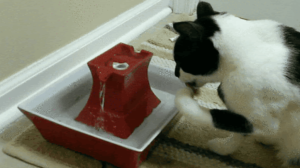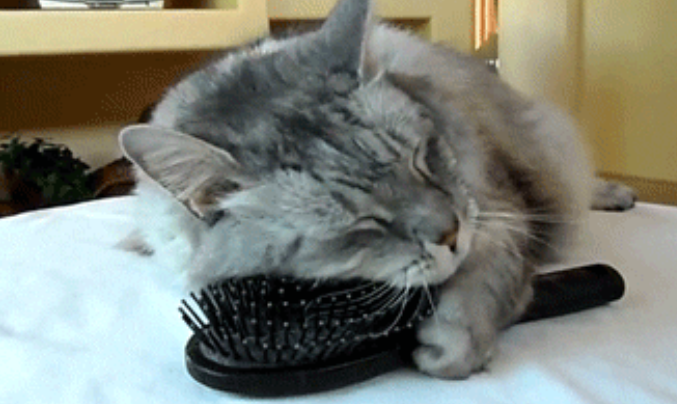The Definition of Senior Age for Indoor Cats.Typically, indoor cats are considered to be seniors at around 8 to 10 years old. However, in reality, cats begin to show signs of aging as early as 4 to 5 years old, with noticeable wear on their teeth and a general decline in physical health. Just like humans, the earlier you start taking care of your cat’s well-being, the better. So, what behaviors can be considered “scientific self-care” for cats? How can you slow down the aging process, improve their quality of life, and extend their lifespan? We’ve summarized 7 simple yet effective wellness tips for your cat.
-
Regularly Brush Your Cat’s Fur
Whether you have a short-haired or long-haired cat, regular brushing is essential. It helps remove dead fur, preventing your cat from ingesting too much hair while grooming, which can reduce the occurrence of hairballs and prevent repeated irritation to their digestive system. Additionally, brushing provides an opportunity to check for abnormalities on your cat’s body and skin, such as wounds, lumps, or tumors.
-
Provide Clean Water Daily and Clean the Cat Bowl
A study by Hartpury University in the UK showed that after just three days of not washing a cat’s bowl, harmful bacterial colonies, including MRSA and Salmonella, can reach levels that pose health risks. The buildup of bacteria and biofilm in the water bowl can make the water stale, acidic, and less appetizing for your cat, leading to dehydration. To prevent kidney disease and urinary tract infections, which are common in senior cats, ensure you replace the water daily and keep the bowl clean.
-
Use Enough Litter and Clean the Litter Box Regularly
The general rule is to have at least one more litter box than the number of cats in the household. The litter should be 5 to 8 cm deep, and the litter box should be scooped once or twice a day. Providing a clean and comfortable restroom environment encourages good bathroom habits in cats, and it helps you monitor vital health indicators such as urination frequency, volume, and whether they are urinating outside the box. Inappropriate urination can sometimes result from a dirty litter box, but it may also signal urinary infections or other health issues. A veterinary check-up is recommended for proper diagnosis.

-
Encourage Your Cat to Use a Scratching Post
Scratching posts not only prevent your cat from damaging furniture but also help your cat stretch its muscles and keep their claws in optimal condition. This is especially important for older cats, overweight cats, or those suffering from arthritis, who might not get enough exercise. Cats with thickened claws may find it difficult to shed their nails, causing them to curl inwards, potentially leading to infection or injury. You can try various types of scratching posts (wood, cardboard, sisal, carpet) and different shapes (horizontal, vertical, curved) to see which your cat prefers.
-
Play and Interaction
Playing with your cat stimulates their body and mind, helping them stay physically active, maintain muscle mass, and prevent obesity. It’s one of the simplest and most effective ways to enrich your cat’s environment. Regular playtime also boosts your cat’s mood and mental well-being. This is especially important for indoor cats, who may lack stimulation and need extra interaction with their owners to stay healthy both mentally and physically.
-
Brushing Your Cat’s Teeth
Just like humans, cats can develop plaque on their teeth, which, if left unaddressed, turns into tartar. This can lead to gum disease, cavities, and even bacterial infections that enter the bloodstream, causing serious health issues and shortening your cat’s lifespan. It’s best to start brushing your cat’s teeth at a young age, but if your cat is already an adult, you can begin by slowly getting them used to having the toothbrush in their mouth. Consistency is key—don’t worry about brushing their teeth perfectly in one go, just make it a regular habit.
-
Get Your Cat Comfortable with a Carrier
Throughout their lives, cats will inevitably face situations that require traveling, such as moving to a new home or visiting the vet. This becomes especially important as they age. Regular health check-ups are crucial, ideally every 1 to 2 years, and for cats with a history of health issues, check-ups every six months may be necessary. However, cats are naturally cautious and can be stressed by unfamiliar situations. To make these visits less stressful, it’s important to start desensitizing your cat to their carrier early. This helps them adapt to travel, making future trips less traumatic and more manageable.
These are the 7 wellness habits that can help your cat live a longer, healthier life. Cat owners, it’s never too late to start implementing these tips—make sure to fill in any gaps and start today!





